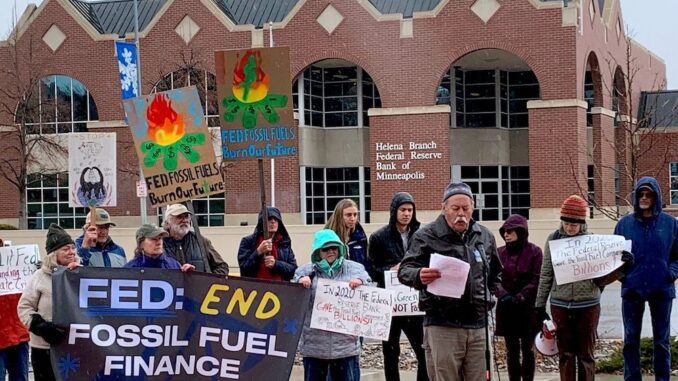
Mindful of the urgency reinforced by a powerful new report by international climate scientists, 350 Montana got busy as the snow melted and the Covid pandemic loosened its grip. It’s our mission to speed the great transition to clean energy, and this spring we did so in the courtroom, in the streets, in educational settings, in opinion pieces published statewide, and in offices of NorthWestern Energy, our rogue utility, during the company’s annual stockholders’ meeting.
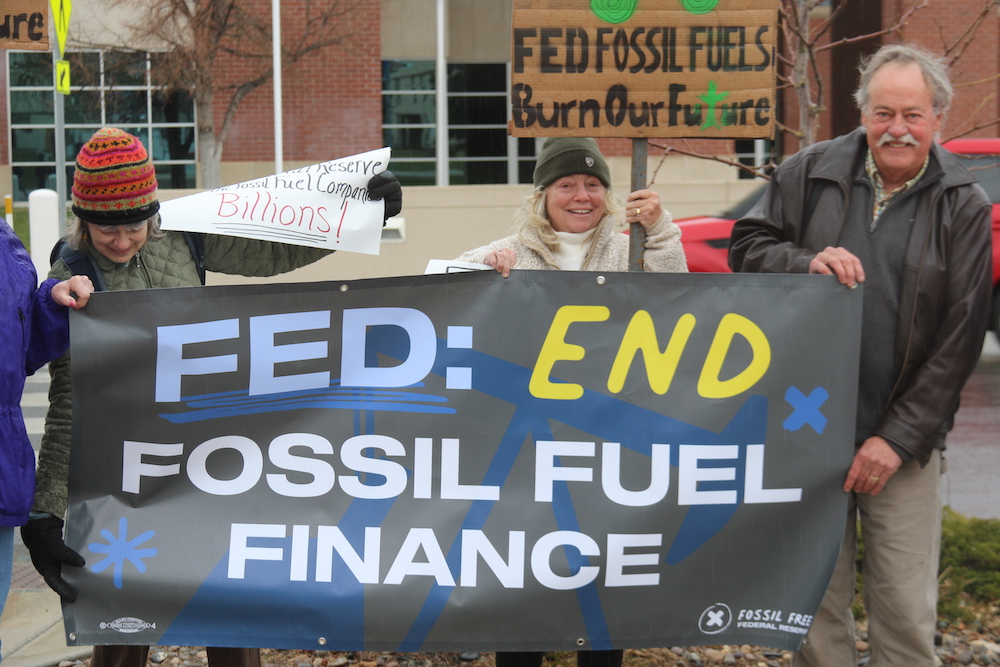
Our spring offensive began just as winter changed to spring with a March 23 hearing in Judge Jason Marks’ Missoula courtroom. Dozens of 350 Montana friends and supporters gobbled up every seat in the gallery and then spilled over into the jury box. When NorthWestern Energy’s suite of lawyers arrived, for a few minutes they couldn’t find seats. Our two lawyers squared off with NorthWestern Energy’s lawyers and those representing Montana Attorney General Austin Knudsen. At stake was the constitutionality of what company lobbyists called a “glidepath,” a “pre-approval” statute meant to curtail public participation and regulatory oversight. Read more about the lawsuit.
The spring offensive continued when 350 Montana joined with Families for a Livable Climate for a “fossil free Friday” pop-up demonstration at NorthWestern Energy’s Missoula offices on the first of April. At the microphone, Jeff Smith from 350 Montana (YouTube video of the audio) joined David Merrill from the Montana Sierra Club and Families for a Livable Climate’s executive director Winona Bateman to demand that NorthWestern stop building a whole new generation of greenhouse-gas-spewing power plants. It felt good to be out expressing our opinions after so many on-line meetings. Learn more the April 1 demonstration.
Then we changed gears. We moved from expressing ideas in the street to expressing ideas in an educational forum on April 18. Nobel-Peace-Prize-winning climate scientist Steve Running graciously agreed to speak at our action committee. More than 70 people joined us at the First Methodist Church in downtown Missoula. We both live-streamed Steve’s talk on Facebook and videotaped it for later broadcast on Missoula Community Access Television. Steve reviewed the latest assessment published by the IPCC and then talked about the successes and failures of the climate movement. Learn more about Steve Running’s talk.
On Friday, April 22, on the 50th anniversary of the first Earth Day, 350 Montana joined in a nationwide rally to call attention to the disastrous climate policies of the Federal Reserve Bank. It just so happens that one of the nation’s 24 Federal Reserve Branch Banks is located in Helena. So off we went on a 350 Montana road trip to meet up with people from Missoula, Helena, and Bozeman. It’s time to shut off all subsidies to oil companies. It’s time for oil companies to pay the social and environmental costs of their greenhouse gas emissions. This has long been part of the climate movement’s strategy. The Federal Reserve’s abysmal record over the last several years includes funding fossil fuel companies to the tune of $2 trillion in the last two years. Enough is enough! Learn more about the Helena rally.
The final action of the month was NorthWestern Energy’s annual stockholders’ meeting. Several members of 350 Montana’s leadership team purchased stock in the company several years ago so we could participate. Three years ago we held a street rally in front of the company’s Butte office building, dropped our signs, walked inside, showed our stock certificates, and entered the meeting. Two years ago we went to court with the stockholders’ resolution. This year we attended the meeting on-line, but that didn’t stop us from asking as many questions as allowed. Read more about the Northwestern stockholders’ meeting.
Learn more about the lawsuit.
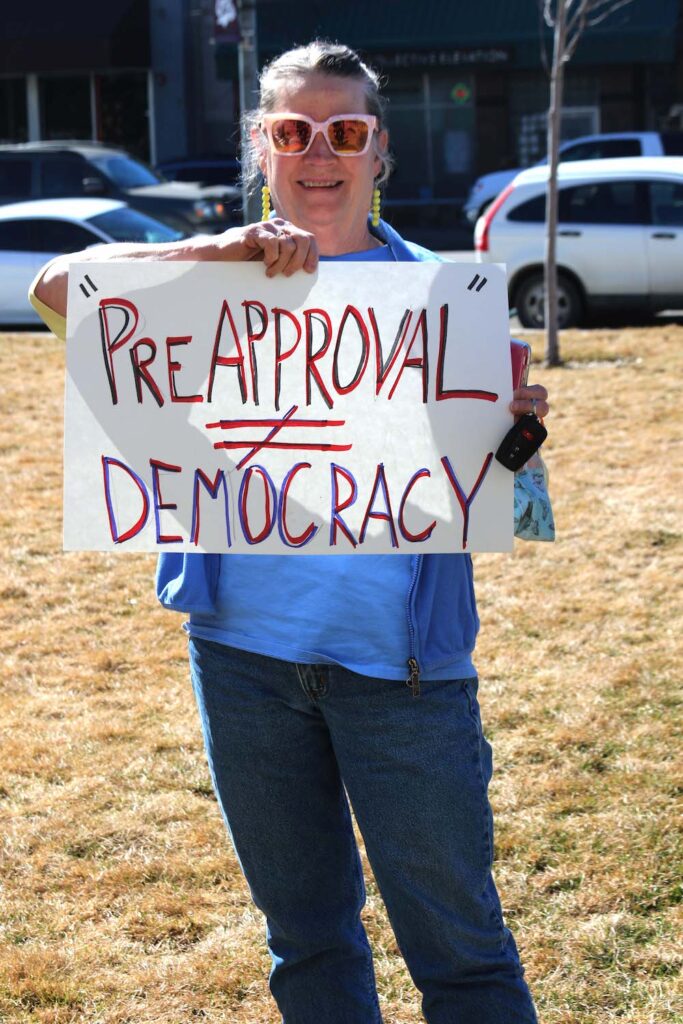
“We don’t think the law should shortcut the oversight of a monopoly by the Montana Public Service Commission (PSC) and the people of Montana,” 350 Montana’s co-chair Jeff Smith told a press conference on the steps of the Missoula County Courthouse after the “pre-approval” hearing on March 23.
Our lawyers, Monica Tranel and Tom Tosdal, volunteered hundreds of hours to file this lawsuit last spring (2021) and then fended off NorthWestern Energy’s repeated attempts to dismiss, delay, or obfuscate their efforts. The audience in Judge Jason Marks’ overcrowded courtroom heard our lawyers’ argue that the Montana Legislature passed this law to allow NorthWestern Energy and no other utility to overbill its Montana ratepayers. The law has allowed NorthWestern to cash in way beyond its purchase prices, including $217 million in extra fees beyond the price paid for 30 percent portion of coal-fired Colstrip-4 in 2007 and $247 million tacked on when the company purchased Montana’s hydroelectric dams in 2014. That’s a half-billion dollars NorthWestern’s ratepayers will be paying through at least 2042.
When Public Service Commissioners agree to “pre-approve” the company’s terms, the PSC can’t revisit its decision. Montana ratepayers are stuck with these inflated costs in each and every monthly bill. They will continue to do so for the foreseeable future.
NorthWestern may already know which way the wind is blowing because it withdrew its proposed $275 million Laurel methane generator from the “pre-approval” process.
Stay tuned. Judge Marks appeared very skeptical of NorthWestern’s excuses for raiding the piggy bank, and he will decide later this spring whether “pre-approval” is an unconstitutional special privilege to a private company.
Learn more the April 1 Demonstration
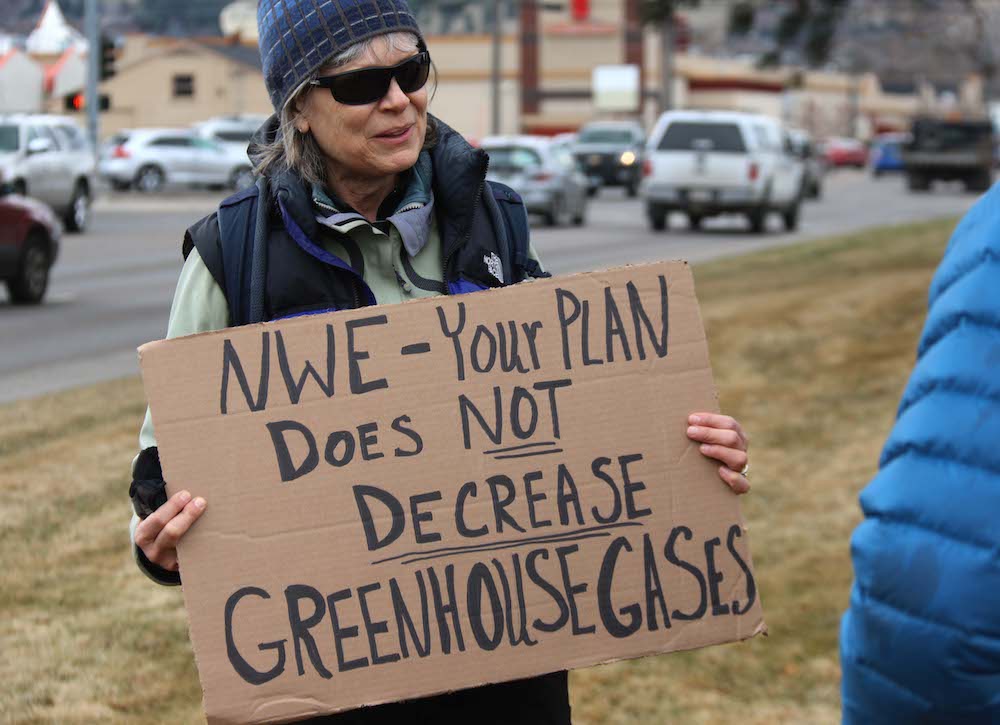
Buffeted by nearly constant criticism of its plans to continue burning coal and methane, NorthWestern Energy pretended to change course in late winter. The idea was to use the words of the climate movement but to do nothing to reduce its greenhouse gases. This pretense is called greenwashing, and NorthWestern has gone pro.
The good news is that NorthWestern is listening to the overwhelming consensus of its ratepayers who have turned up the heat at every public hearing in the past five years to excoriate the company for ignoring the urgency of global warming. The bad news is that its new “Net Zero” plan is a public relations stunt.
To great fanfare, with bill-stuffers for its 300,000 Montana customers, paid advertising on radio and television, a new website design, and op-eds by the company CEO Bob Rowe in Montana newspapers, NorthWestern trumpeted its new “Net Zero” plan as the next best thing to sliced bread. But, as Montana Nobel Prize winning climate scientist Steve Running wrote on March 13 in his blistering op-ed in The Montana Standard, the plan is “quite literally too little, and much too late.”
The Intergovernmental Panel on Climate Change in its recent 6th assessment warned that the world has just one decade to substantially reduce fossil fuel emissions or we will blow past the 1.5 Centigrade ceiling that stabilizes this planet. NorthWestern wants to wait until 2050 to cut its greenhouse gas pollution to meet the wrong threshold (2 C). A junior high student who got those two key facts wrong would flunk.
This is the backdrop for the “fossil free Friday” demonstration at the company’s Missoula headquarters on April 1. 350 Montana’s Jeff Smith couldn’t help wondering aloud if the company was a regulated public utility or a death cult.
Jeff said, “CEO Bob Rowe didn’t ask how he might bring NorthWestern into compliance with the level of the threat and pitch in to stop Montana’s megafires, the slow agonizing death of our rivers and streams, get a handle on our extreme weather events like the fire that roared through Denton on December first, and try to avert this ongoing drought, the worst in 1,200 years, devastating our world-class agriculture.
“Instead, Bob asked, how can we distract investors and put a smiley face on our soaring corporate profits and greenhouse gas emissions?”
You can see a video of Jeff’s speech here or read Jeff’s op-ed in The Billings Gazette here.
Learn more about Steve Running’s talk.
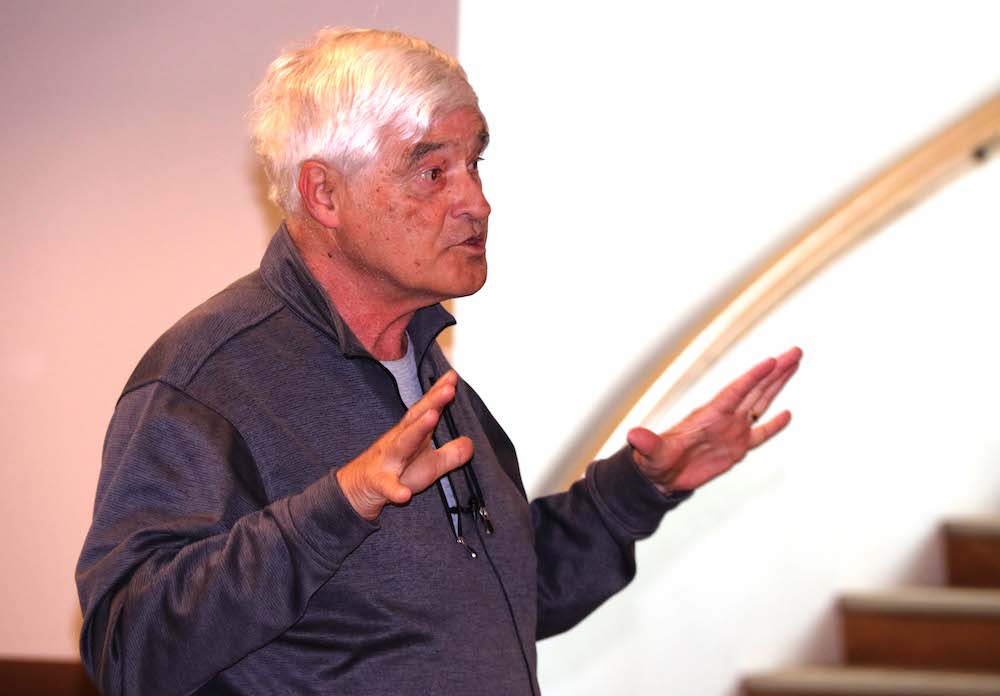
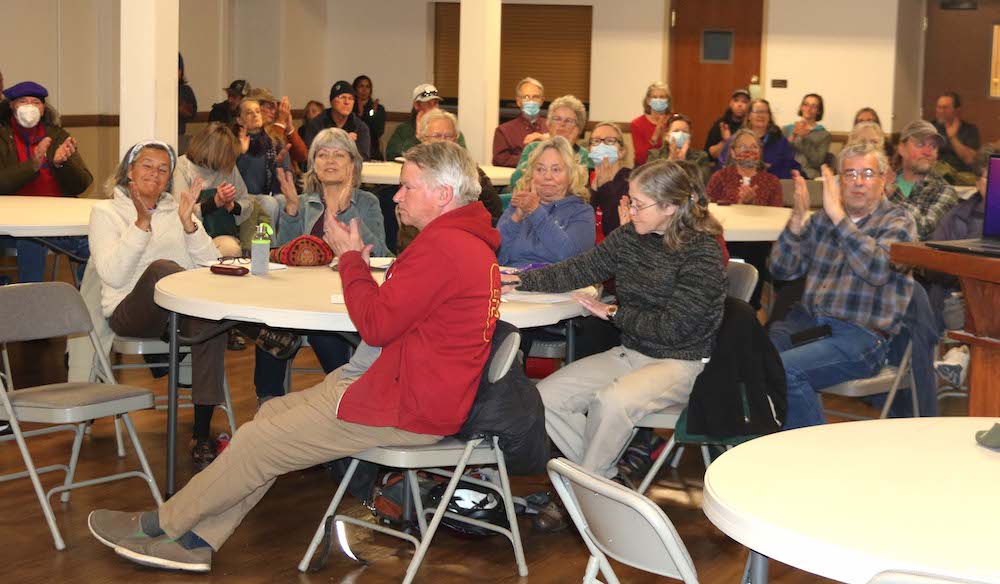
In his talk on April 18, Steve Running said he’s been disappointed with the results of 30 years of doom-and-gloom messaging from people in the climate movement, and he wanted, at this meeting, to talk about the progress being made by scientists and activists. You can see the whole talk here.
The trends are continuing as they have been since the Intergovernmental Panel on Climate Change (IPCC) started tracking them back in the 1980s. Emissions are continuing to go up. Temperatures are also going up. “There is no doubt that we’re not even flattening the curve yet,” Running said. That means there’s almost no chance we’re going to restrain temperatures below the target set by the IPCC, which is 1.5 C.
But the good news is that our climate is dynamic. As soon as we flatten this curve by cutting emissions, temperatures will follow. “We don’t have to accomplish everything today,” he said. “We just have to change the momentum.” Mitigations are working. Never before has renewable energy been cheaper. Wind and solar are hands down the cheapest way to generate electricity. “We’ve done fabulously well technologically and economically by bringing wind and solar on,” Running said. That’s why NorthWestern Energy’s stance – continuing to use coal and building methane plants – is so lame, he said.
“We’re making progress on a number of things that really matter,” he said. When the U.S. improves grid connectivity, we will have the flexibility to pull electricity from places where the wind is blowing and the sun is shining. We are also on the cusp of making tons of progress on electric vehicles. Electric bikes for short trips around town are really useful. We know how to build well-insulated houses with heat pumps, using all electric power that could come from carbon-free generators. We see the way forward.
Finally, Running talked about taking heart at the progress we are making. Our climate is dynamic and will respond when we lower greenhouse gas emissions.
You can see the Facebook recording of the entire speech here, and you can read Steve’s op-ed about why NorthWestern Energy’s new plan is disappointing in The Montana Standard here.
Learn more about the Helena rally.
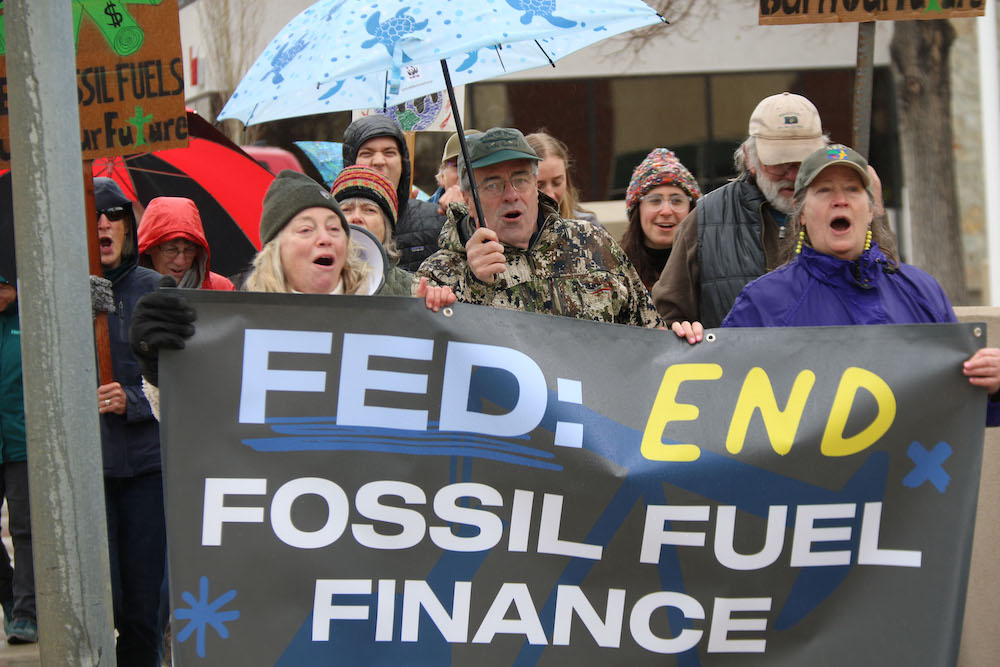
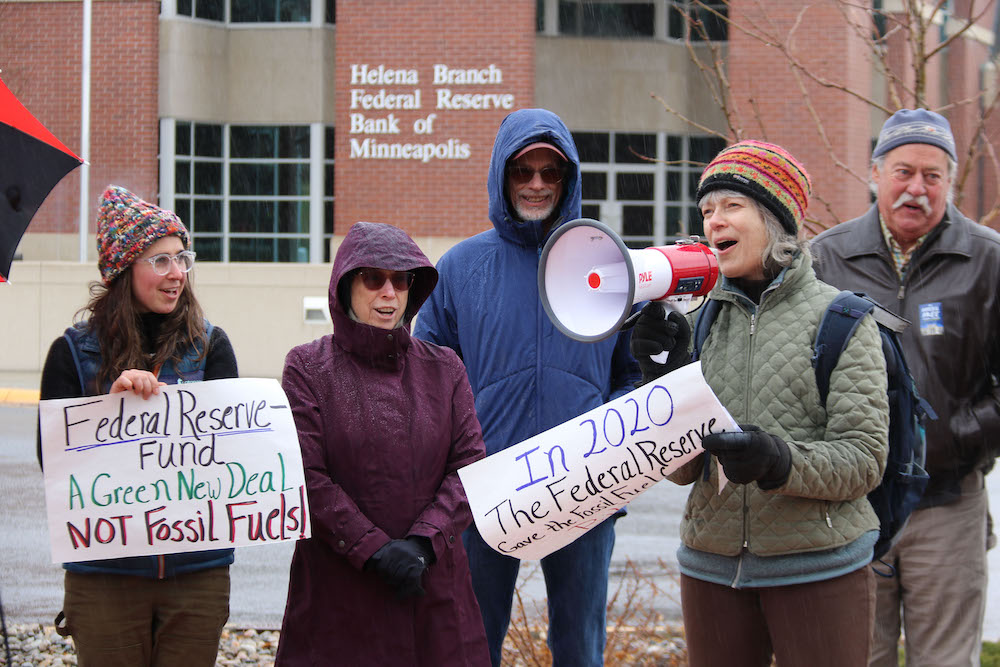
It was rainy and cold, a reluctant spring day, but that didn’t matter. The van full of 350 Montana people jumped out in Helena on April 22. We immediately gathered protest signs and scouted Hill Park, across the street from our target, the Helena Branch of the Federal Reserve Bank. We set up a microphone as people streamed in from Bozeman and Helena. Eric Ristau from One Acre Films arrived to record the rally. We were charged up in spite of the rain.
“In Montana we don’t have to wait for climate change. It’s already here,” Jeff Smith told the crowd. “We can see the four horsemen of the Montana apocalypse – megafires, extreme weather events, dying rivers and streams, and even more pronounced drought – taking their horses out of the barn. They’re saddled and ready to ride . . . unless we reverse the policies of the Federal Reserve.”
Smith told the crowd the Federal Reserve Bank was supposed to be the referee that guides secure investment and serves the American people by managing risk and avoiding catastrophes. We put forth these demands:
● END BANK FOSSIL FUEL FINANCE: Use existing regulatory and supervisory tools to limit and phase down financing of emissions.
● DIVEST AND INVEST: Align Fed spending and asset purchases with the Paris Climate Agreement’s goal of <1.5°C temperature increase.
● PUSH BANKS TO INVEST: Encourage bank investment aligned with the Paris Climate Agreement, especially when it comes to clean energy.
Lucy Hochschartner of the Gallatin Sunrise Movement told the crowd that Montana Senator Steve Daines hasn’t been showing up for his job on the Senate Banking Committee and he needs to appoint nominees to the board that governs the Bank. Ian Lund of the Montana Environmental Information Center said that the bank used Covid mitigation funds to subsidize oil companies.
Our Helena rally received top billing in a video portraying the rallies occurring across the country on Earth Day. Go here to see 350 Montana in this short national video summary.
Learn more about 350 Montana at NorthWestern Energy’s stockholders’ meeting.
Pressing for greenhouse gas reductions at NorthWestern’s annual stockholders’ meeting has been an ongoing 350 Montana campaign. But, with corporate protections written into the law, the annual stockholders’ meeting usually brings about as much excitement as a dental visit or driver’s license renewal.
Three years ago while holding a sign and standing on the street in front of NorthWestern’s corporate headquarters inn Butte, an urbanely dressed man approached and asked what we were doing. After an explanation, he said he fully supported our right to demonstrate. Then he asked what our issues were. We explained. We had a lively dialog about renewables and storage technologies. We found out when the company’s board of directors. He wrote later in a letter – after we wrote him to continue the dialog – that he had insisted NorthWestern’s executives accompany him to the Gordon Butte pump storage site near Martinsdale, Montana.
Two years ago, spurred by Ovando lawyer Tom Tosdal, we submitted a stockholders’ resolution that would have created an economic study to weight the costs of fossil fuels versus renewables. NorthWestern promptly rejected the resolution, and we promptly took them to federal court. The case went before a federal judge in Missoula, who rejected it based on his finding that current law permitted company executives great latitude in managing their stockholders.
This year, the meeting was virtual. A completely static graphic of the company logo presented itself on the computer screen. CEO Bob Rowe droned on and on with the wonderful successes of the company in spite of difficult challenges. The only way for a stockholder to participate was to upload questions. And we submitted five:
1. Do you consider it a moral hazard to be spending millions of dollars on public relations promoting a “net zero” plan that, in the words of Montana’s Nobel Prize winning climate scientist, Steve Running, is “too little, too late”?
2. How likely will NWE choose to build a nuclear reactor, and do you think Montanans will accept the risks, given the history of the WPPSS $2 billion blunder and Three-Mile Island disaster?
3. Studies like the Rocky Mountain Institute’s “Seeds of Opportunity” predict that utility-scale wind and solar will bring $60 billion a year in economic development to rural communities like those in eastern Montana. Why is NWE opting for centralized energy generation that would offer no such dispersed, community development investment?
4. Why does NWE’s proposed “net zero” plan ignore the IPCC’s global warming ceiling of 1.5 C and the IPCC’s timeline for substantially reducing greenhouse gas emissions by 2030?
5. The future energy grid is going to be made up of many distributed energy resources. Does Northwestern have an innovation team studying the most cost-effective ways of investing in a smart, decentralized grid?
To his credit, Bob answered four of the five questions, albeit in dismissive fashion. At least he knows we are paying attention.